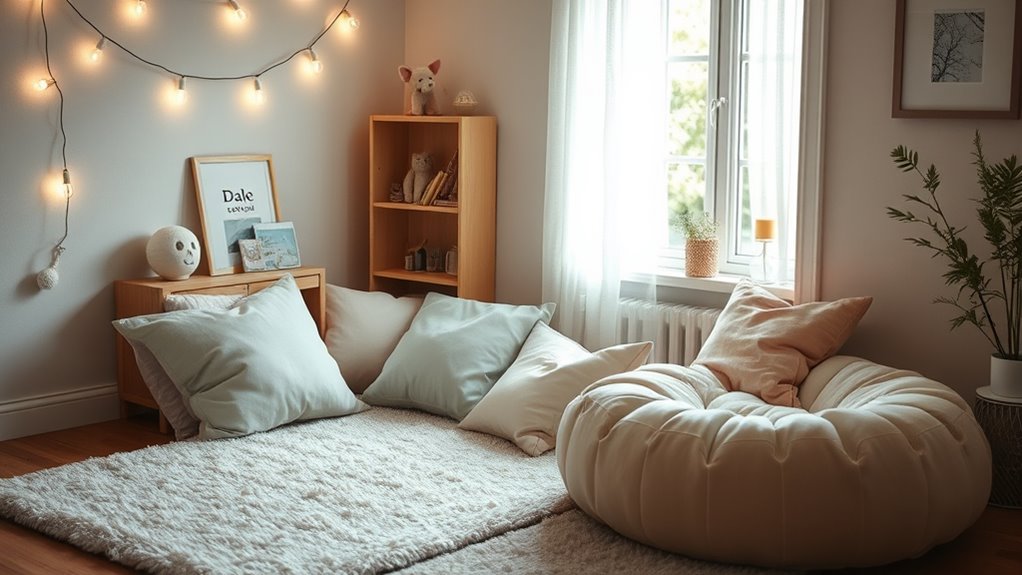To design a calming corner with sensory supports, start by selecting soft lighting like warm lamps or fairy lights to create a soothing ambiance. Incorporate textured items such as plush blankets and stress toys, and add calming scents with diffusers or scented candles. Arrange comfortable furniture and organize your sensory tools within easy reach in a clutter-free space. Incorporate natural elements like plants and natural light to enhance tranquility. Keep exploring for tips on creating your perfect relaxation zone.
Key Takeaways
- Incorporate soft, warm lighting and calming artwork to create a soothing visual environment.
- Arrange sensory tools like plush blankets, stress balls, and aromatherapy within easy reach for accessibility.
- Choose comfortable furniture and organized storage to promote relaxation and reduce clutter.
- Use natural elements such as plants and natural light to enhance tranquility and connect with nature.
- Position the space in a quiet, low-noise area to maximize serenity and sensory engagement.

Creating a calming corner in your space provides a dedicated refuge where you can relax, decompress, and recharge. This special spot isn’t just about adding cozy elements; it’s about intentionally designing a space that promotes tranquility through thoughtful use of sensory tools and an effective space layout. When you plan your calming corner, focus on creating an environment that appeals to the senses and fosters a sense of safety and comfort.
Start by considering the sensory tools you want to include. These are essential for helping you regulate your emotions and soothe your mind. Soft lighting, like a small lamp with warm tones or fairy lights, creates a gentle ambiance that signals relaxation. Incorporate textured items such as plush blankets, stress balls, or fidget toys that engage your sense of touch. Aromatherapy diffusers or scented candles can also play a significant role, offering calming scents like lavender or chamomile that help reduce stress and promote calmness. Visual stimuli should be minimal but intentional—perhaps a small collection of calming artwork, nature scenes, or a tabletop fountain that produces soothing sounds. These sensory tools work together to create an immersive environment conducive to relaxation.
Equally important is the space layout. You want to arrange your calming corner so it feels inviting and easy to access. Place your sensory tools within arm’s reach, avoiding clutter that can cause distraction or stress. Use furniture that encourages comfort—think a cozy chair or a floor cushion with supportive backing. Keep the area organized with storage solutions like baskets or shelves, so your sensory tools are always easy to find and put away. Position the corner in a quiet part of your home, away from busy areas and noise sources, to maximize tranquility. If possible, incorporate natural elements like plants or a small window for natural light, as these can enhance your sense of serenity and connection to nature.
Frequently Asked Questions
How Can I Personalize the Calming Corner for Different Children?
You can personalize the calming corner by observing each child’s individual preferences and developmental needs. Incorporate favorite sensory items, like textured fabrics or calming lights, that resonate with them. Adjust the space based on their age and sensory sensitivities, adding tools like noise-canceling headphones or soft pillows. Regularly communicate with children and caregivers to update the corner, ensuring it remains a supportive and inviting space tailored to each child’s unique needs.
What Materials Are Safest for Sensory Supports?
You should choose sensory support materials made from non-toxic, hypoallergenic options to guarantee safety for all children. Look for items like silicone, organic cotton, and BPA-free plastics, which are safe and gentle on skin. Avoid any materials with harsh chemicals or strong scents. Always check labels and opt for products specifically designed for children’s safety, giving you peace of mind as you create a calming, secure environment.
How Often Should I Update Sensory Tools in the Corner?
You should update your sensory tools in the calming corner at least every few months, or whenever they show signs of wear and tear—think of it as a sensory tool replacement frenzy! This keeps the space invigorating and engaging, preventing boredom and ensuring safety. Regularly revitalizing the calming corner creates a sensory experience that feels new and exciting, helping kids stay calm and engaged without feeling like they’re stuck in the same old routine.
Can a Calming Corner Be Used for Group Activities?
Yes, a calming corner can be used for group activities to promote shared relaxation and group engagement. You can organize guided mindful exercises or gentle sensory activities that encourage everyone to participate together. This approach helps build a sense of community, reduces stress, and allows children to learn calming techniques collaboratively. Just make certain the space remains inviting and adaptable, so all participants feel comfortable and engaged during group use.
How Do I Measure the Effectiveness of the Calming Corner?
To measure the effectiveness of your calming corner, start with a sensory assessment to identify individual needs. Track how often and how long users engage with the space, noting changes in behavior or mood. Use observation checklists or feedback forms to gather data regularly. Effectiveness tracking helps you determine if the calming corner supports relaxation and reduces stress, allowing you to make adjustments for better results.
Conclusion
So, there you have it—your very own sanctuary of serenity, where chaos goes to hide and you get to pretend you’re in a spa instead of a bustling household. Just imagine the bliss of retreating to your calming corner, surrounded by soft textures and soothing lights, while the world outside keeps spinning. Who knew that creating a tiny oasis could turn you into a zen master? Now, go ahead—make your space so peaceful even your stress will envy it.









